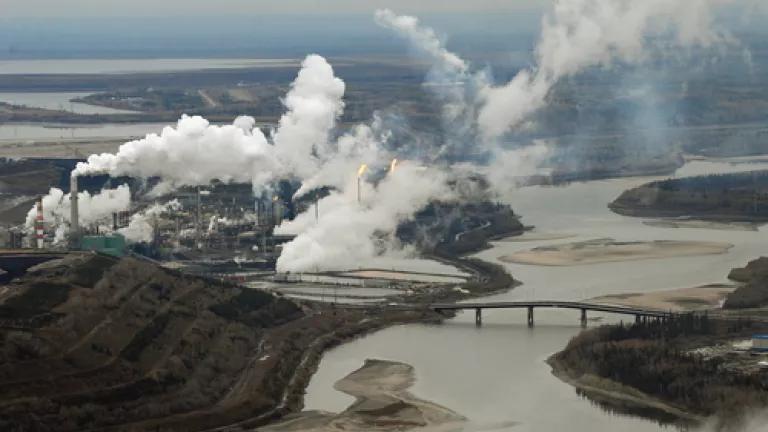Alberta's Opportunity: What the International Community Expects from the Province's Climate Plan

After years of being the epicenter of Canada's declining reputation on environment and climate, Alberta has the opportunity to establish itself as a climate leader. The province - which is known internationally for its environmentally damaging tar sands, rapidly growing carbon emissions and broken climate commitments - plans to announce a comprehensive climate policy in advance of the international negotiations in Paris later this year. Led by the recently elected New Democratic Party (NDP), Alberta has a real opportunity to demonstrate that it is changing the course on climate. As the Natural Resources Defense Council (NRDC) highlighted in recommendations to Alberta's Climate Change Advisory Panel, an internationally credible climate policy will require a set of policies that will yield absolute emissions reductions which will enable both the province and Canada to realize their climate commitments. The tools that Alberta has at its disposal, including carbon pricing, oil and gas regulations, a phase out of coal, and support for efficiency and renewable energy should be sufficiently ambitious to meet that objective. As the international community prepares to meet in Paris to discuss a path forward to limit global warming to two degrees Celsius, Alberta's government must not miss this opportunity to change its current course and make meaningful emissions reductions while building an economy that will prosper in a low carbon future.
Previous Albertan governments have used climate announcements - composed of unenforced climate targets, promises of carbon reducing technology in the future, and weak carbon taxes with little emission benefit - as tools to "greenwash" increased tar sands production and related expansion infrastructure. The results have been predictable - an expanding tar sands sector, rapidly increasing provincial emissions and leading to broken commitments by both Alberta and Canada. The province's increasing emissions from the expanding tar sands sector - Alberta expects its emissions to be 27% higher than 2005 levels by 2020 - is the primary reason Canada is expected to be the only developed country to miss its Copenhagen climate targets by a substantial margin.
To regain its credibility and remove its metaphorical black eye, Alberta's comprehensive climate package must be more than a talking point to lobby for the expansion of the tar sands. Alberta's comprehensive climate package must actually bend its emissions curve in a manner that will allow the province to reduce its absolute emissions and Canada to meet its international climate commitments. The tools that Alberta has at its disposal, including carbon pricing, oil and gas regulations, a phase out of coal, and support for efficiency and renewable energy should be sufficiently ambitious to meet that objective.
This objective cannot be accomplished without putting limits on Alberta's largest source of emissions - the tar sands. That will require enforceable policies that establish a cap on the sectors absolute emissions in the near term and increase in stringency in a predictable fashion to the extent necessary for the province to enable Canada to meet its 2030 and 2050 climate targets. Whether Alberta chooses to move forward with an economy-wide carbon tax or a cap-and-trade system with ambitious emission caps will require careful analysis of the likely absolute emission reductions achievable under either system. Only a system that achieves these absolute emission reductions is appropriate for Alberta, or any other province, at a time when emission reductions are of critical national and international importance.
By all indications, the Albertans are ready for strong action on climate - recent polling shows a majority believe the province is responsible for reducing its carbon emissions and support stronger climate policies, while a plurality believe that the tar sands should not be expanded.
Transitioning the province's economy to low carbon industries isn't only the best outcome for the environment, it's the best outcome for Alberta's long term economic future. As the international community prepares to meet in Paris to negotiate ambitious steps to address climate, the International Energy Agency (IEA) forecasts that the global demand for petroleum products will begin a long term decline in 2020 if the international community adopts the policies necessary to prevent global warming from exceeding two degrees Celsius. This lower demand scenario suggests that Alberta should avoid investing its long term economic future in a market that will soon begin to deteriorate.
As Canada's largest emitter, and the province witnessing the most rapid growth in emissions, Alberta is in a position to not only lead Canada by announcing when its emissions will peak with an overall emissions cap, but also how it will help Canada to get back on track to meet its 2030 INDC targets (which is a minimum intermediate step toward realigning Canada with its more ambitious 2050 target). In doing so, it also has an opportunity to drive the country toward the critical greenhouse gas emission cuts necessary through the 2050 time frame. Unlike the position it finds itself in today, Alberta could then push other provinces to meet their own targets, opening the door for true provincial collaboration in meeting the greenhouse gas emission and climate challenges facing Canada.

